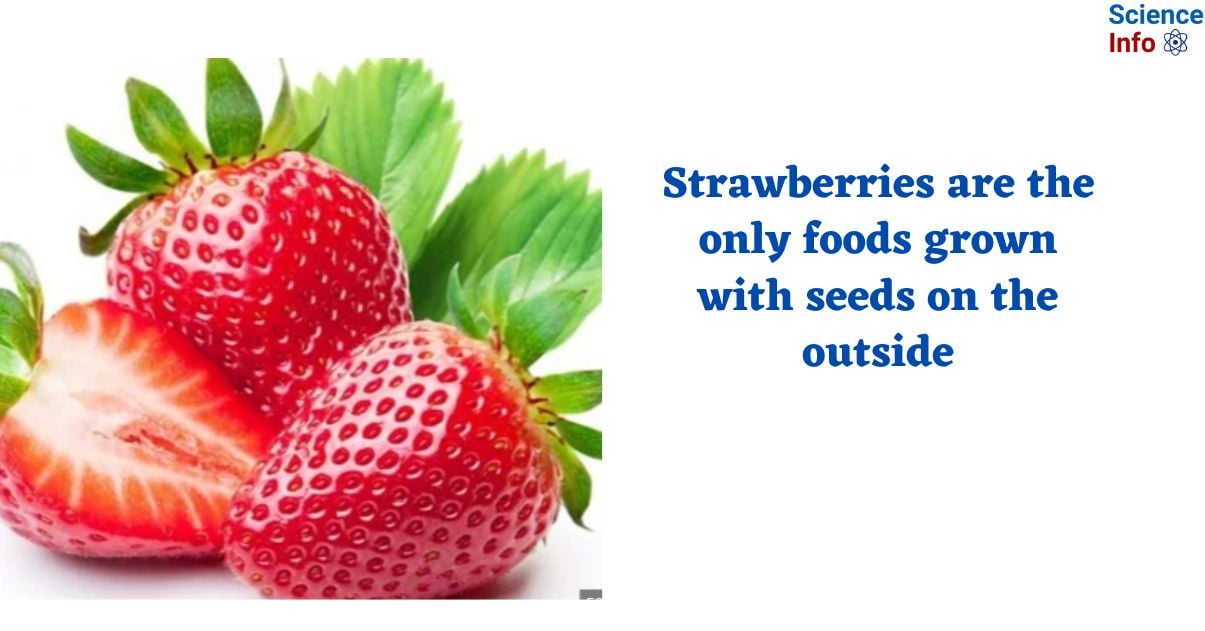A popular fruit, strawberries are known for their vivid red color and delicious flavor. Strawberries are the only foods grown with seeds on the outside and is one of its most fascinating features. Strawberries differ from most other fruits in this way.

Unlike blueberries or grapes, strawberries are not real berries. Berries are technically required to contain seeds inside of them. Strawberry seeds are not simply external; according to botanists, or plant scientists, each seed that is visible on the fruit’s exterior is a distinct fruit with its own seed.
Interesting Science Videos
Strawberries are the only foods grown with seeds on the outside. Myth or Fact?
Strawberries have seeds on their outside, unlike most other fruits whose seeds are hidden inside the flesh. A single strawberry can contain up to 200 seeds, which makes them an exciting topic for botany study.

[Image source: https://strawberryplants.org/strawberry-seeds/]
The microscopic structures on a strawberry’s surface that we refer to as seeds are actually called achenes. An achene is a tiny, dry fruit with one seed inside of it. The fleshy, red portion of the strawberry that we eat is actually an expanded flower receptacle rather than a true fruit.
Strawberry: A False Fruit
The strawberry is referred to by botanists as a “false fruit,” or pseudocarp. Essentially, a strawberry is a multi-fruit composed of numerous small individual fruits contained within a fleshy receptacle. The real fruits, known as achenes, are the brownish or yellowish dots that are usually mistaken for seeds. Each achenes is surrounded by a tiny seed.
Strawberry is an example of a false fruit. In botanical terms, a fruit is a fully developed seed that has structure and is made exclusively of the carpels or ovaries of a single flower. Depending on how the seeds are dispersed, this might or might not be fleshy. In several species, different floral tissues serve as seed dispersal systems. The base or receptacle of the strawberry bloom contains numerous individual carpels embedded in it. The fleshy portion of the piece we eat is a false fruit because it is comprised entirely of receptacle tissue. The fruit is what seems to be the “seeds” on the surface, and each dried carpel wall holds a single seed with a separate coat.
An achene is a dry fruit with only one seed and one seed. In a similar vein, a large number of other well-known “fruit” are complex botanically: Apple: the part we eat is a receptacle, while the carpels make up the core.
Why Are Strawberry Seeds on the Outside?
The strawberry blossom has multiple ovaries, all of which produce fruits. However, in contrast to other fruits, where the ovaries grow to make the tasty fruit that we all love, the strawberry’s receptacle expands to form the red, edible portion that we are all familiar with. What we’ve always mistaken for the strawberry fruit’s red core is actually an organ that supports the growth of both the fruit and the blossom.
Subsequently, the strawberry flower’s petals fall off as the tiny ovary fruits become embedded on the surface of the enlarged container. These tiny, beige-colored seeds are actually the strawberry’s fruit, not the seeds. Each of these microscopic fruits contains a smaller seed that needs to germinate in order to start the entire process over.
References
- https://news.ncsu.edu/2016/05/strawberry-seeds-2016/
- https://12tomatoes.com/strawberries-seeds-on-the-outside/
- https://fruidel.com/fruity-fact-a-strawberry-isnt-technically-a-berry-or-even-a-fruit/
- https://www.theguardian.com/notesandqueries/query/0,5753,-23052,00.html
- https://kckplprograms.org/2021/06/10/culinary-literacy-strawberries-the-only-fruit-with-the-seeds-on-the-outside/
